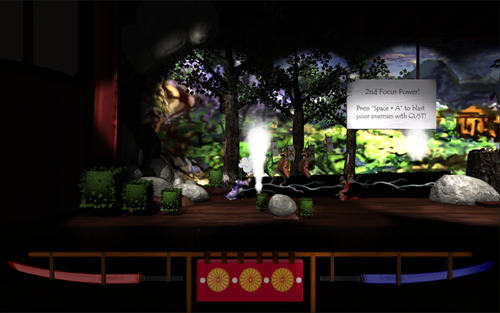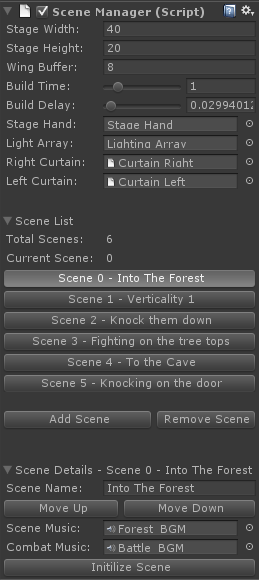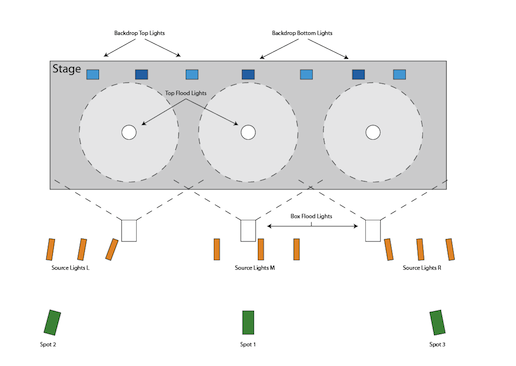Satoshi and the Thousand Samurai
Overview
Satoshi and the Thousand Samurai is a side-scrolling beat-em-up style game that takes place onstage as a Kabuki play. Players take the role of Satoshi Tengoku, a powerful samurai, as he journeys to rescue his sister Hiyori, a wielder of deadly elemental powers, from the clutches of the evil Earthborn clan.
Satoshi features:
- A unique special move system with six distinct abilities
- Theater-inspired sets, lighting, and environments
- Three different enemy types
- Three unique bosses
I was the lead designer on Satoshi. The game was built by a team of seven to twelve people in the Unity engine from September 2011 through April 2012.
-
Combat Design

Combat in Satoshi is built in levels of progression that effectively reset every combat encounter, requiring the player to start with his most basic attacks every time.
The basic attacks are broken up into light attacks that are quick and do little damage and heavy attacks that hit opponents on both sides of the player, doing large amounts of damage. Additionally, the player can parry incoming attacks and dodge around opponents.
Special Abilities
The player has access to two sections of special abilities that pull from their own resource: Flow and Focus. Each section has two offensive abilities and one defensive ability.
Flow is generated by hitting opponents with basic attacks and by parrying incoming attacks. Flow attacks originate from Satoshi and are manifestations his own Ki and fighting prowess.
Focus is generated by hitting opponents with Flow attacks. Focus attacks originate from Hiyori, who joins Satoshi in his quest for revenge after he rescues her. Focus is powered by Hiyori's elemental abilities, and features attacks such as lighting bolts and a torrent of ice spikes.
Both Flow and Focus are reduced by taking damage, so in order for the player to maintain access to the special abilities, he must fight with skill and precision.
The Combat Loop
Access to attacks is restricted based on the strength of the attacks. Basic attacks are the weakest, and they allow access to Flow attacks which in turn allow access to Focus attacks.
Thus, at the start of any battle, the player will first skirmish with his opponents close-up in order to generate Flow. Once the player has access to his Flow abilities, he can deal with multiple opponents more effectively and also earn Focus, which he will then use to finish off his opponents and deal with any newcomers to the battle.
-
Development Tools
The use of the stage presented some unique challenges in the development of Satoshi. There were two distinct features we wanted to really sell the player on being in a theater. We wanted the environment props to move on and off the stage similar to the way they would in real scene transitions, and we wanted to have a lighting system that mimicked a real theater's rig.

Scene Manager
Because the game is played on a stage, all of the scenes are actually in the same place. This is not just a gameplay concern, but also a development concern. I didn't want to make my level designers have to guess where the objects they were placing were going to be.
I built a scene manager framework with a custom Unity inspector to alleviate these problems. The custom inspector gave the level designers on the team an easy and foolproof way to see and edit each scene individually, even though all the objects were actually in the same place.
Once the game is actually running, objects in a new scene are teleported offstage into the wings of the stage and then moved in dynamically. To add to the effect, stage hands accompany those objects onto the stage before running off themselves.
Lighting System
The lighting system in Satoshi is directly based off of actual theater lighting setups. I drew upon my and Yenni Brusco's experience in theater to design a lighting rig that would match what might be seen in a real theater while still working in a game environment. For example, to achieve different colors onstage, theaters use a combination of red, green, and blue lights. However, we were able to simply color the emitted light itself and thus cut down on the number of dynamic lights we would need.

With the lighting system in place, I created another custom inspector that went along with the scene manager. This allowed the level designers to easily see the lighting for each scene at the click of a button and update the lighting for each scene individually with ease.
- Lorem ipsum dolor sit amet, consectetur adipiscing elit. Nam bibendum libero vel lorem scelerisque dictum. Maecenas velit mi, cursus et ullamcorper nec, egestas eget ipsum. Nulla sit amet fermentum nunc. Aliquam venenatis risus nec tellus lacinia in adipiscing libero bibendum. Proin tincidunt odio ac lorem rhoncus venenatis. Fusce rhoncus lectus sit amet tortor commodo in varius turpis viverra. Duis at felis tellus. Pellentesque et sem sed nibh viverra dignissim.
